Reveals the hidden complexity of dental biofilm
Meet Professor Sebastian Schlafer, whose research on dental biofilm – another word for bacterial plaque on teeth – creates a new understanding of caries and provides opportunities for more targeted approaches to caries control.
From microorganisms to new treatment practice
"I’m fascinated by the complex microbial architecture of dental biofilms, where bacteria collaborate, compete and create completely unique microenvironments," says Sebastian Schlafer.
""I’m fascinated by the complex microbial architecture of dental biofilms"
The professor conducts research on the composition and architecture of biofilms and the metabolic processes that lead to biofilm diseases such as caries.
By studying how bacteria organise themselves, he is working on developing more gentle treatment methods that do not disturb the natural ecology of the mouth or harm beneficial bacteria in the oral cavity.
Searching for more targeted approaches to caries control
Caries is the most common disease worldwide, but treatment is often symptom-based. Sebastian Schlafer aims to develop treatments that directly regulate processes in the biofilm, thereby reducing the need for invasive treatment.
"I want to find methods that target the causes behind the disease instead of just the symptoms"
“To date, the most widespread caries treatment is nothing else than an amputation. We remove part of a damaged tooth and replace it with a filling. But I want to find methods that target the causes behind the disease instead of just the symptoms," he says.
According to the professor, exploring the molecular mechanisms behind caries and developing treatments that focus on the actual cause of the disease can benefit the entire population.
Dreaming of precise interventions
Sebastian Schlafer and his research group are also deeply committed to exploring the architecture and functionality of the biofilm matrix – the protective slime layer surrounding the bacteria.
"We still know very little about its composition and the exact function of its different polymeric components"
"The matrix plays a key role in biofilm resistance and virulence, but we still know very little about its composition and the exact function of its different polymeric components," he explains.
The professor is convinced that a more nuanced approach to oral microorganisms can revolutionise the way we prevent and treat diseases.

4 highlights about Sebastian Schlafer
- Has developed new, non-biocidal strategies for caries control.
- Has had his research published in leading journals and received external research funding – including from the Aarhus University Research Foundation.
- Recruits and supervises new research talents.
- Born in 1979 and became fascinated by the world of microbiology during a lecture on bacteria in periodontal lesions.